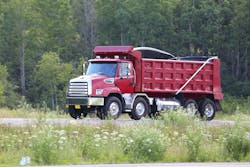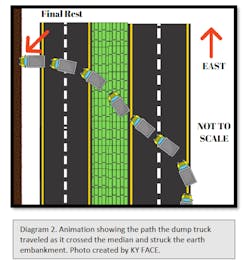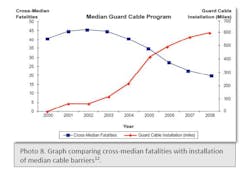Fatality Investigation: Dump Truck Driver Dies After Steer Axle Tire Failure
The Kentucky Fatality Assessment and Control Evaluation (FACE) Program is tasked with investigating fatalities and making recommendations to ensure they do not occur again. This is one of their recent cases.
On Tuesday, Aug. 20, 2019, a dump truck driver was operating a 1981 Chevrolet, C-70 dump truck eastbound on a major four-lane Kentucky interstate en route to the driver’s place of business.
The victim had just purchased the dump truck he was operating earlier that evening at an out-of-state auction. At 12:40 a.m., the driver’s side steer axle tire failed and disintegrated while the vehicle was traveling at an estimated speed of 70 mph.
Yaw marks present on the right shoulder of the eastbound lanes suggest the driver attempted to oversteer to compensate for the blown tire, but was unable to maintain proper control of the vehicle. The dump truck exited the travel portion of the highway to the left and entered into the grassy median that separates the east and westbound lanes of traffic.
Due to the absence of a barrier, the vehicle continued across the median and into the westbound traffic lanes. The truck traveled across the westbound traffic lanes and struck an earth embankment located on the right shoulder of the westbound lanes.
The force associated with striking the earth embankment severely damaged the driver’s portion of the cab. First responders arrived on the scene of the crash within ten minutes of the incident. Upon approaching the vehicle, it was determined that the driver had succumbed to the injuries sustained in the crash, and he was pronounced dead at the scene. Accident investigators determined the victim was not wearing a seat belt.
According to the death certificate, the cause of death was multiple blunt force trauma sustained in a motor vehicle collision.
Contributing Factors
Occupational injuries and fatalities are often the result of one or more contributing factors or key events in a larger sequence of events that ultimately result in the injury or fatality. NIOSH investigators identified the following unrecognized hazards as key contributing factors in this incident:
- Equipment failure
- Failure to wear seat belt
- Lack of barrier in median
Recommendations
1. Commercial motor vehicle (CMV) operators should utilize seat belts when driving commercial vehicles.
Discussion: The victim was not wearing a seat belt at the time of the collision. Wearing a seat belt can greatly reduce the severity of injuries sustained in a crash. A 2013 study released by the Federal Motor Carrier Safety Administration (FMCSA) reported that dump truck drivers have the lowest seat belt usage rate (70%) of all commercial motor vehicle body types4. In combination with low seat belt usage rates, incidents involving dump trucks resulted in the fourth-highest number of fatal crashes among all large commercial vehicles. CMV operators should use seat belts when driving commercial vehicles.
2. CMV operators should complete driver vehicle inspection reports on all equipment prior to operating commercial vehicles.
Collision investigators determined that the front driver’s side steer axle tire failed and disintegrated which resulted in the driver losing control of the vehicle and crashing. In 2017, there were 738 tire-related vehicle fatalities in the United States6. Examining not only your tires, but also all vehicle components is a critical step in ensuring the safe operation of a commercial vehicle. The driver, who was also the owner of the company, had just purchased the dump truck earlier that day. The operator had no previous knowledge of the vehicle, it’s mechanical road worthiness or how it had been maintained historically.
3. CMV operators should participate in a defensive driving course.
Great West Casualty Company (GWCC), one the largest commercial vehicle insurers in the United States has categorized collisions into four critical crash categories:
- Rear-end crashes
- Loss-of-control crashes
- Lane change collisions
- Run-under crashes
GWCC has developed defensive driver training to address and prevent each type of critical collision from occurring. GWCC addresses steer-tire blow outs in critical crash type #2, loss-of-control crashes. GWCC says when a steer-tire blowout happens, a driver’s instinct may be to step on the brakes to slow down. Since the unit will naturally pull to the side of the flat tire, applying the brakes could increase the chances of the unit sliding sideways and the driver losing control. The proper reaction should be to accelerate and maintain forward momentum. Gripping the steering wheel firmly, the driver should gently counter steer to offset the side force created by the blowout until control of the unit is regained. At this point, ease off the accelerator until the vehicle is safely stopped9. Defensive driving techniques such as these can be critical to a driver’s success.
4. Install median cable barriers.
No type of median barrier was present at the scene; statistics prove that median cable barriers are an effective countermeasure in reducing the severity of collisions. According to a study conducted by the Michigan Department of Transportation (MDOT) in 2008, the installation of median cable barriers reduced cross-median collision by 87%. Furthermore, both severe injury and fatality collisions were decreased by 33% and rollover collisions reduced by 50% after the installation of median cable barriers10.
The Kentucky highway department should consider installing cable median barriers on all limited access highways and interstates to prevent median crossover collisions.
About the Author
DeAnna McIntosh
Safety Specialist
DeAnna McIntosh currently serves as the safety specialist for the Kentucky Fatality Assessment & Control Evaluation (FACE) Program within KIPRC. With a focus on prevention, her reports analyze a variety of contributing factors to each case, and subsequently make prevention recommendations centered on administrative controls, environmental controls, PPE use and existing safety regulations.


